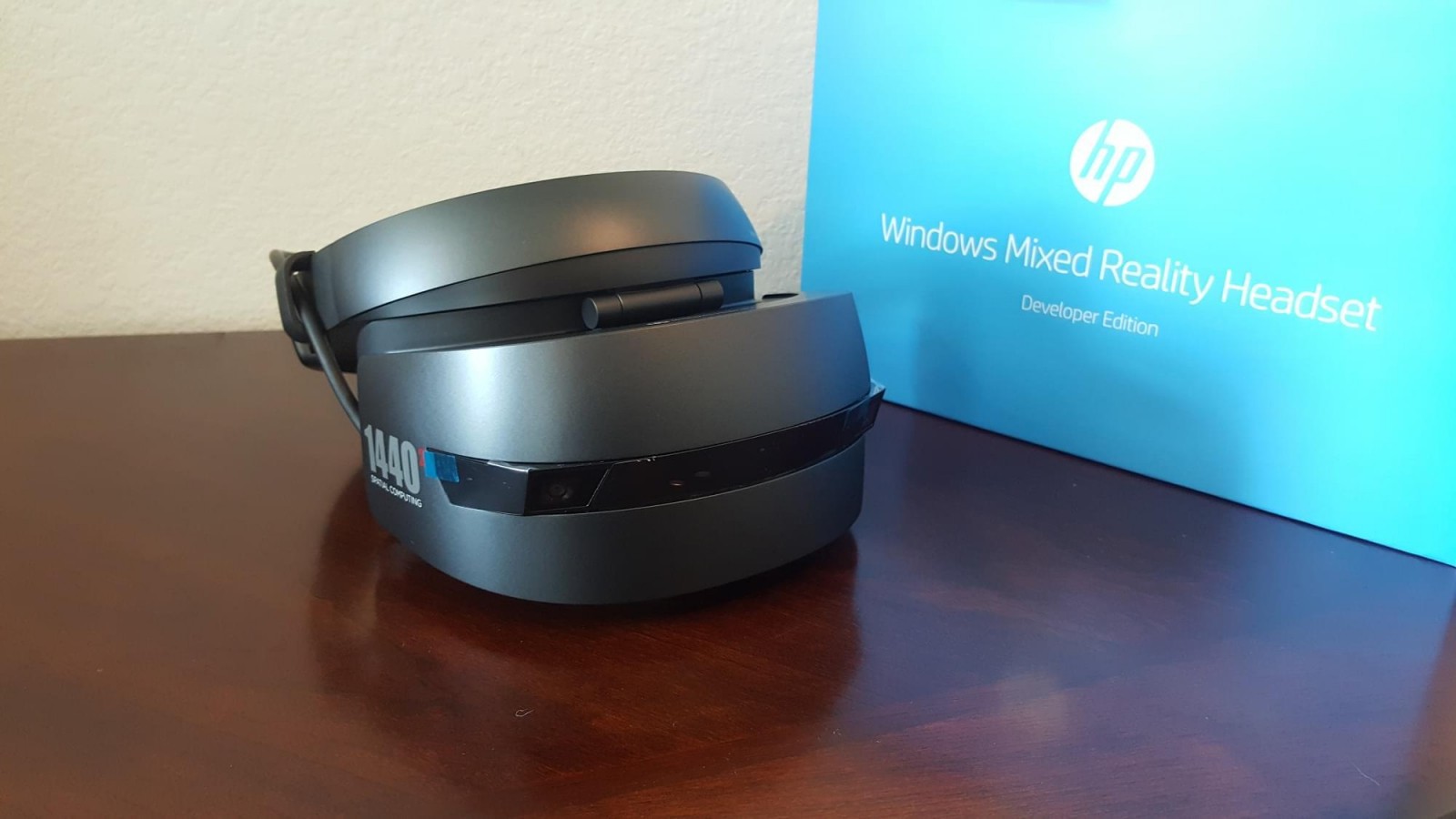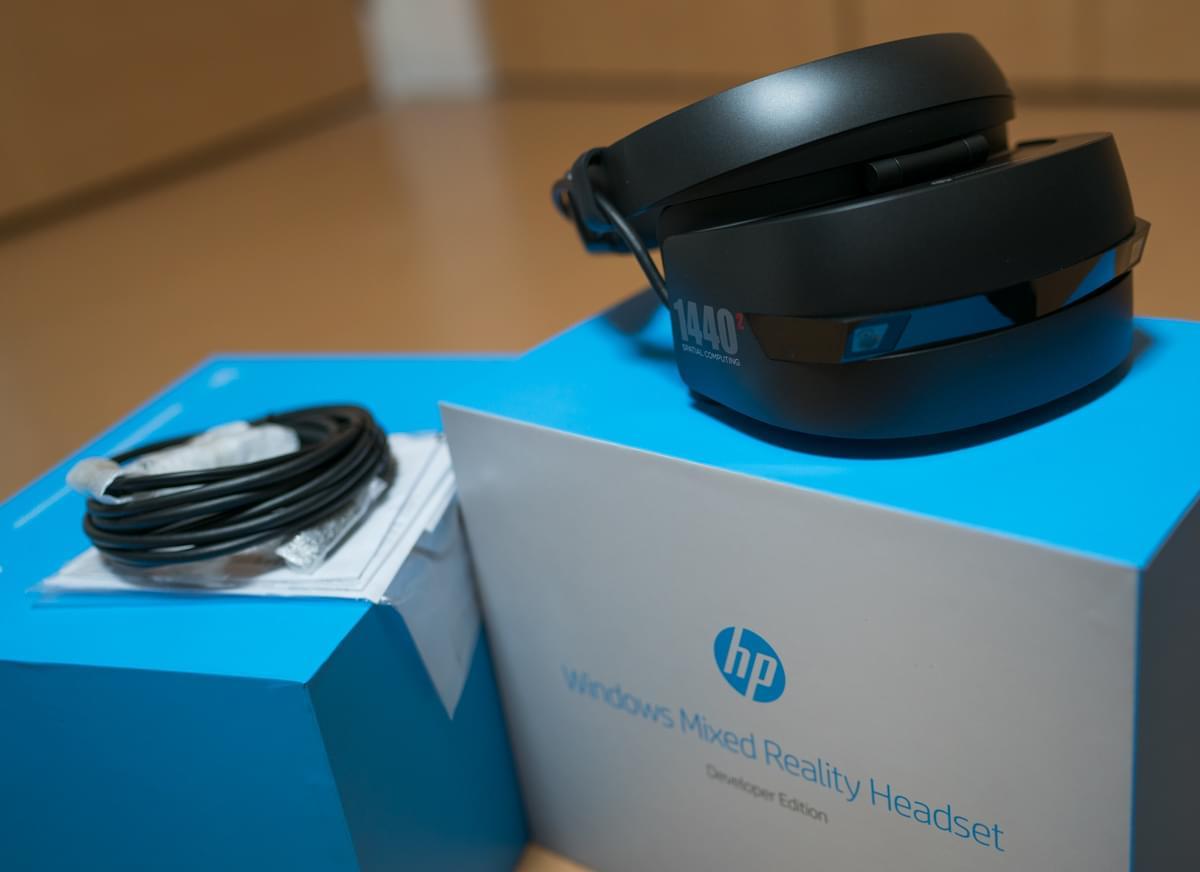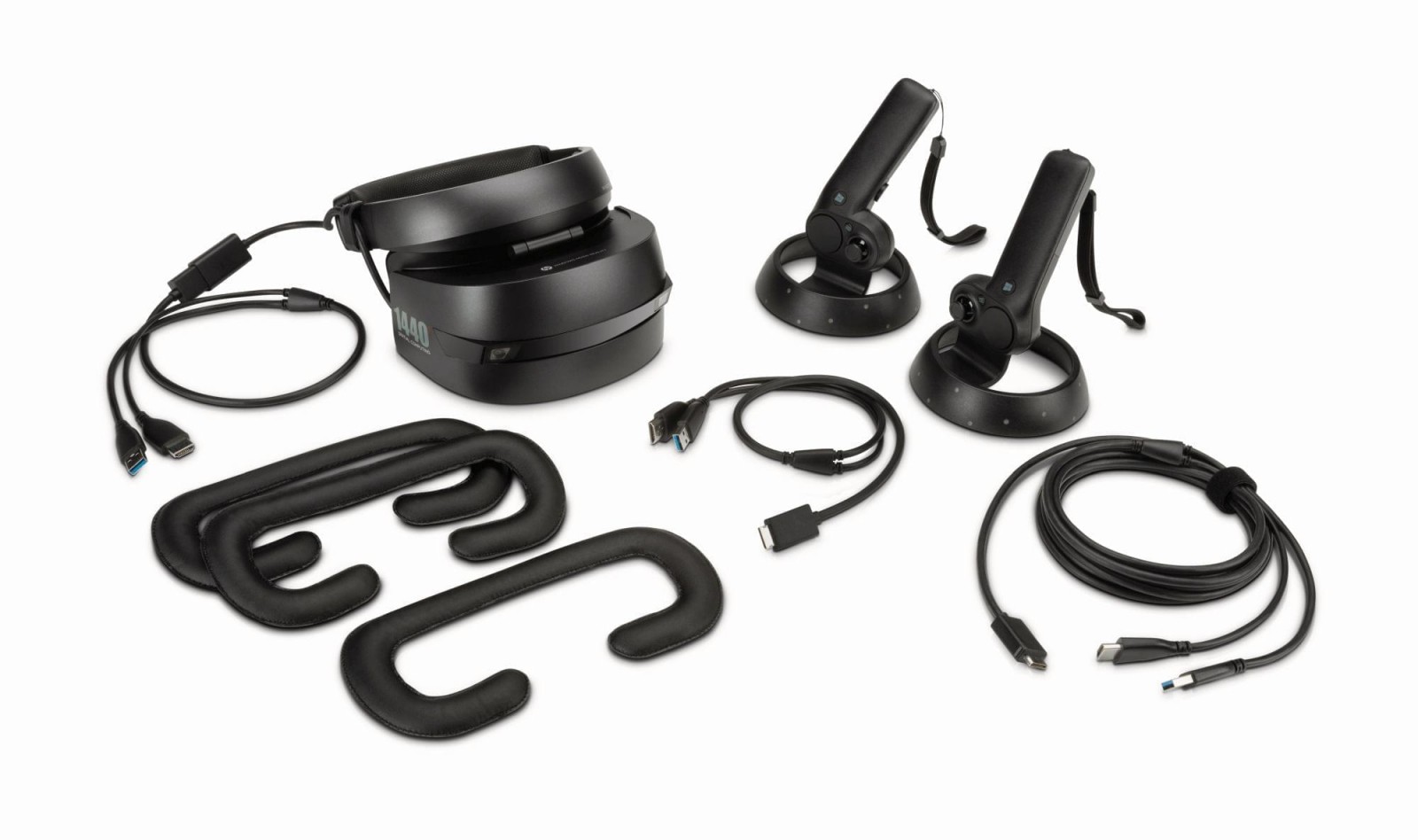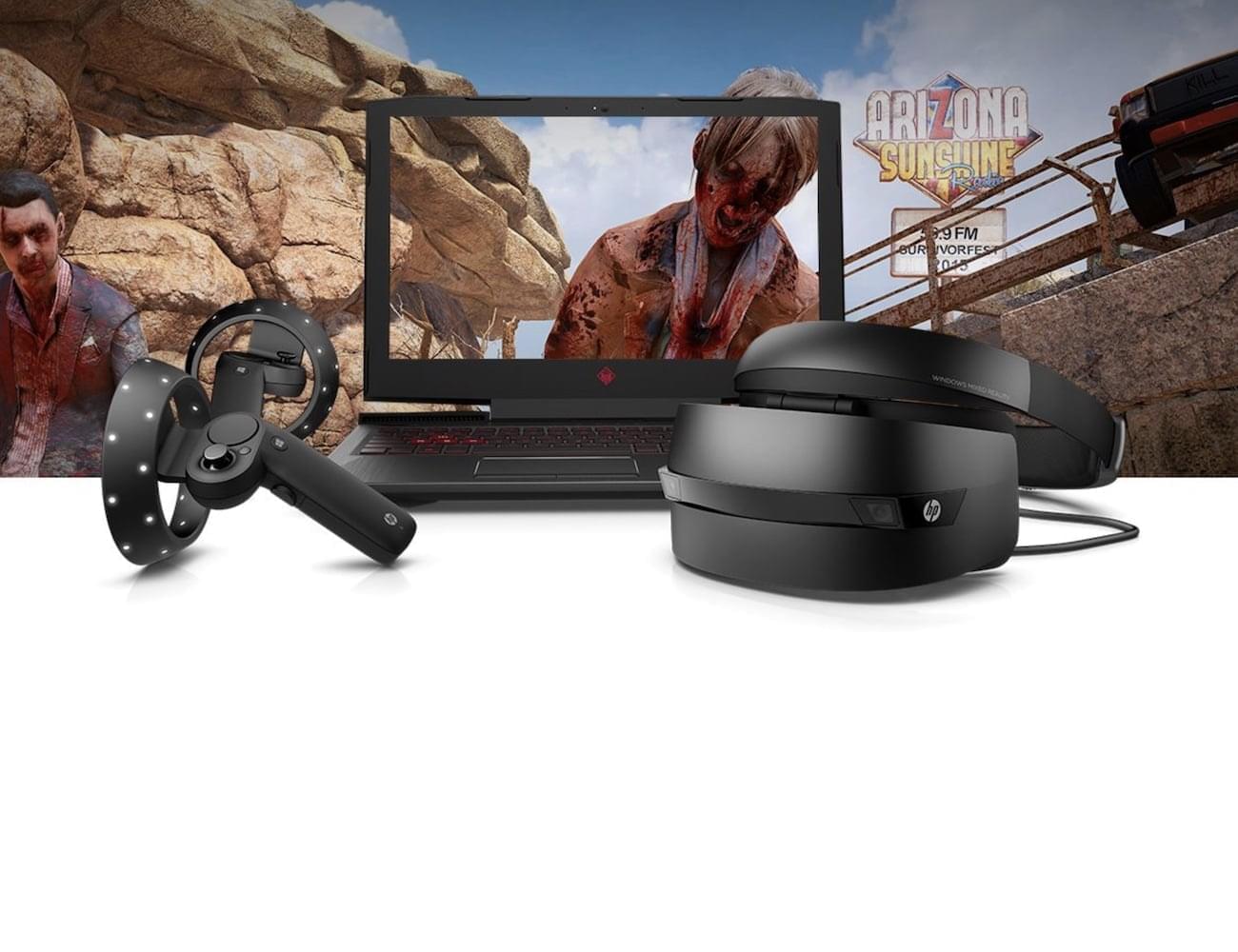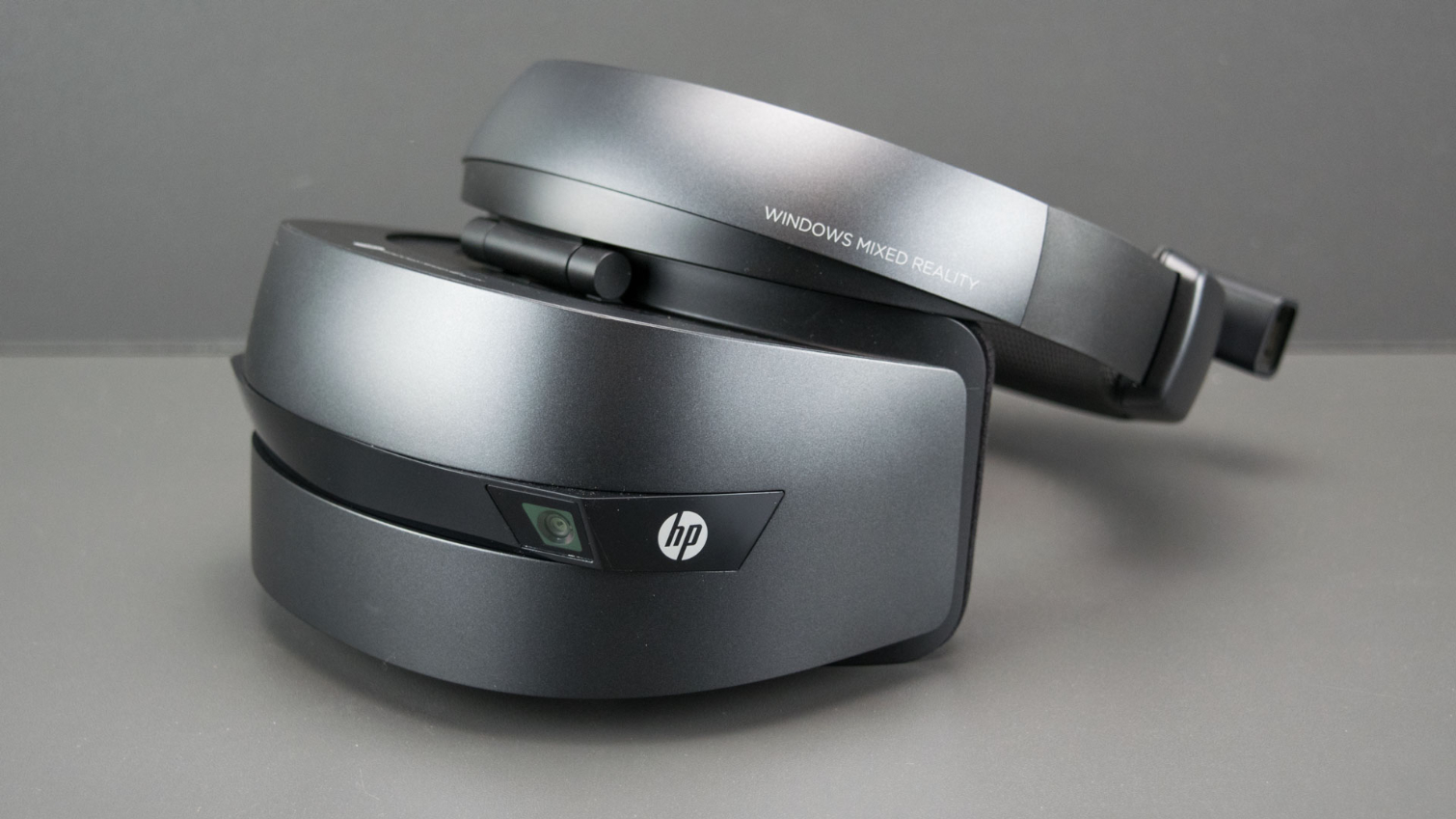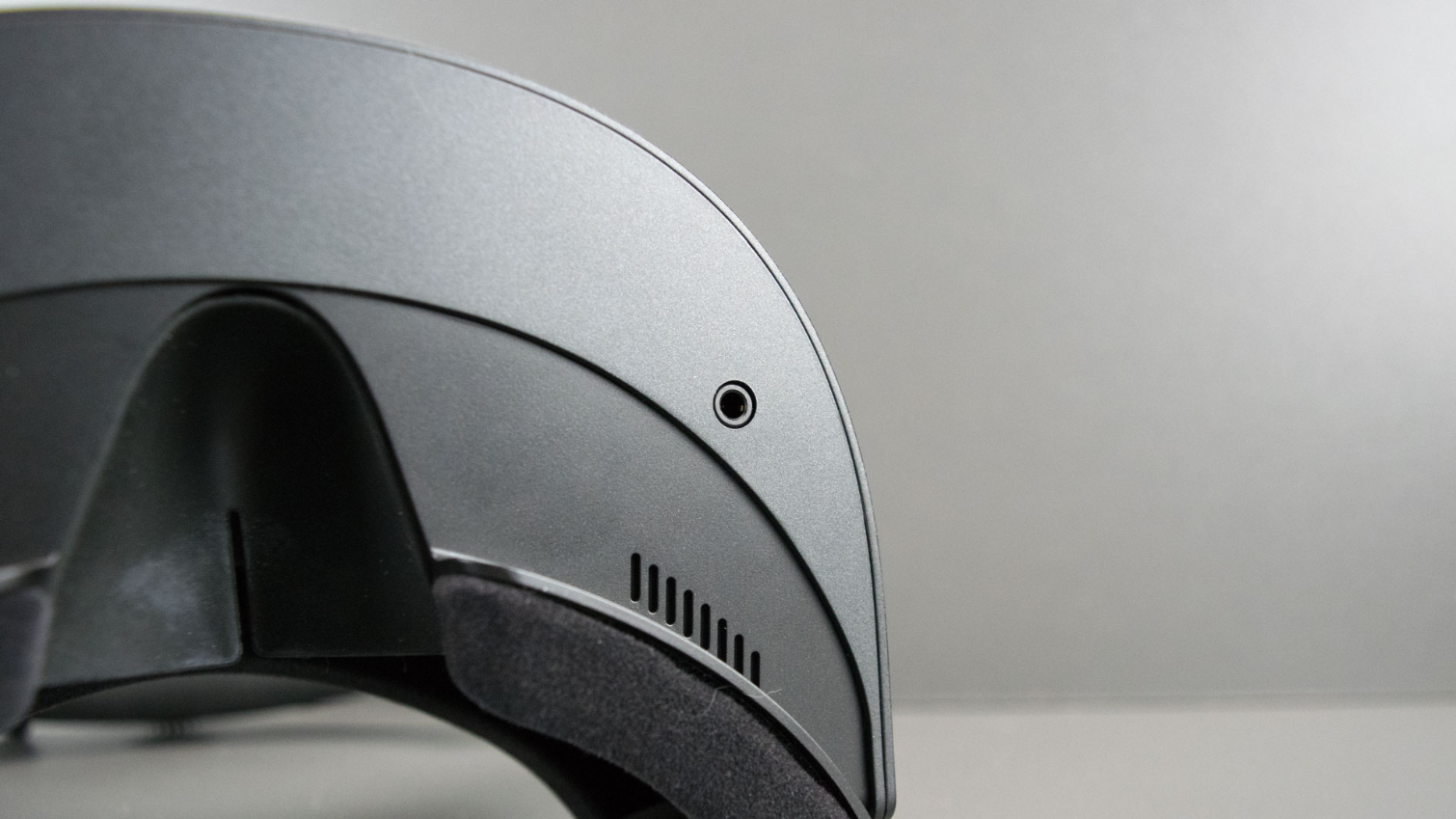В октябре прошедшего года Microsoft проинформировала о том, что она сотрудничает с такими гигантами, как Acer, HP, Asus, Dell и Lenovo для выпуска гарнитур виртуальной реальности. Разработанная версия гарнитуры HP Mixed Reality готова, а все желающие могут заказать ее из Microsoft Store.
Гарнитура рассматриваемой выше модели — это не единственная гарнитура с гибридной реальностью, которая уже выпущена. Аналогичные выпускают многие другие технические компании, такие как Acer, Lenovo, Dell и Asus.
Интересно, что между этими гаджетами существует много общего. Это связано с тем, что все гарнитуры смешанной реальности создаются с использованием одних и тех же виртуальной реальности, программного обеспечения для смешанной реальности. И, соответственно, их технические характеристики (которые подробно приводятся ниже) тоже имеют много общего.
Шлем и гарнитура к нему
Красивый футуристический дизайн мало кого оставляет равнодушным. Гарнитура создана в стильном, глянцевом цвете с множеством тонов, которые смотрятся весьма современно.
Гарнитура HP Mixed Reality использует дизайн с двумя подушками, а не трехсторонний дизайн ремешка, что большинству людей уже знакомо. Хорошо приспособлена для обеспечения удобства и комфорта. Конструкция оголовья пенопластовая, удобно лежит на лбу. Имеется простая регулировочная ручка и шарнирный механизм для удерживания компонента дисплея. Они обеспечивают наилучшее погружение, не напрягая шею или голову. Гарнитуру можно носить в течение многих часов без боли или стресса на мышцах.
Гарнитура виртуальной реальности поставляется с двумя дисплеями, которые обладают высоким разрешением 1440 x 1440. Наибольшее преимущество использования дисплея с высоким разрешением заключается в том, что риск столкнуться с эффектом дверцы экрана весьма минимален.
Гарнитура HP MR стоит немного больше, чем модель Acer. Это связано с тем, что HP внесла свои собственные изменения в стандартный дизайн. Дизайн HP Windows предлагает расширенное пространство для носа и накладку на головном ремне.
Головная гарнитура HP MR оснащена фронтальными камерами. Эти встроенные камеры с сенсорным экраном обеспечивают 6 степеней свободы. Теперь пользователи могут перемещаться во все шесть сторон — направо, вниз, вверх, налево, вперед, назад. HP предлагает поистине захватывающий опыт смешанной реальности, используя позиционное и вращательное (ориентационное) отслеживание.
В комплекте
Гарнитура HP Mixed Reality поставляется с дополнительными составляющими, такими, как клавиатуры, мыши, геймпады для возможности просмотра жестов или голосового контроллера. Функции позиционного отслеживания и вращательного отслеживания, встроенные в гарнитуру и контроллеры движения, предоставляют пользователям свободу воображения. Пользователи могут создавать контент, который они представляют. Единственным ограничением является воображение пользователя.
Гарнитура HP Mixed Reality выпущена в августе 2017 года. На данный момент гарнитура смешанной реальности предназначена только для разработчиков. Но потребительская версия не отстает. Microsoft планирует выпустить потребительские версии MR гарнитуры перед праздничным сезоном.
Цены на популярных сайтах
Версия гарнитуры для разработчиков составляет не более 329 долларов. На вебсайте Microsoft размещено сообщение о том, что спецификации персонального компьютера (ПК) для гарнитуры, указанные на вебсайте, могут отличаться.
Гарнитура HP в настоящее время возглавляет пакет по дисконтированной цене, найденной на Amazon за 225 долларов США, колоссальная скидка 50%, включая контроллеры. На eBay в настоящее время цена упала до 250 долларов США (38% скидка), а на Ozon минимальная стоимость 290 долларов.
Настройка
Гарнитура использует метод «вывертывания», который включает датчик отслеживания движения для отслеживания движения внутри гарнитуры, поэтому вам не нужно устанавливать датчики или камеры дополнительного характера.
Просто присоедините гарнитуру HP Mixed Reality (с контроллером) к ПК с помощью выделенного кабеля (точнее, 2-в-1 HDMI 2.0 и USB 3.0), входящего в комплект поставки. Это все, «подключи и играй».
Размер дисплея:
- Диагональ 2,89 дюйма;
- Разрешение экрана 1440 на 1440
- Периодичность обновления дисплея 90 Гц (максимум);
- Угол обзора горизонтали 100 градусов (максимум).
Каналы синхронизации:
- Аудио вход / выход;
- Комбинированный порт;
- Закрытый кабель;
- Один кабель 2-в-1 с разъемом HDMI 2.0 и USB 3.0.
Желаемые характеристики компьютера (для разработчиков):
- Установленная ОС: 10 версия Windows;
- Intel Core i7 (6+ Core) или AMD Ryzen 7 1700 (8 ядер);
- NVIDIA GTX 980/1060, AMD Радеон RX 480 (два гигабайта или лучше), графический процессор с использованием DX12 и WDDM 2.2;
- Визуальные драйверы: модель драйвера экрана Windows (WDDM) 2.2;
- Мощность: 15 Вт или сильнее;
- HMD: HDMI 1.4 или порт дисплея 1.2 для HMD 60 Гц;
- Оперативка: как минимум 16 гигабайт;
- 32-битная цветность;
- Хранение: от десяти гигабайт добавочного свободного места;
- Подключение: USB: 1 порт USB для HMD | USB 3.0 (тип A) | минимум 900mA;
- Источник питания USB;
- Bluetooth 4.0 или более для присоединения устройств.
Характеристики
- Разработчик — HP;
- Установленная ОС — Windows 10 для девелоперов (включен режим разработчика);
- ЦПУ — Intel Core i7, AMD Ryzen 7 1700 (двенадцать потоков и шесть ядер);
- GPU — NVIDIA GTX 965Ml AMD Радеон RX 480M (два гигабайта);
- Оперативка — как минимум 16 гигабайт (оба ПК LAPTOP, ПК DESKTOP);
- Место хранения — 10 ГБ добавочного свободного места (как LAPTOP PC, DESKTOP PC);
- Дисплей — 2.89;
- Разрешение — 1440×1440 на глаз (2880×1440 в сочетании);
- Частота обновления — 90 Гц при соединении с портом HDMI 2.0 /, 60 Гц при соединении с портом HDMI 1.4;
- Поле зрения — 95 градусов по горизонтали (Френель асферический);
- Отслеживание — 6 степеней свободы плюс отслеживание наизнанку;
- Аудио — 3,5-мм комбинированный аудио разъем;
- камера — 2 фронтальных камеры;
- Датчик — Акселерометр, гироскоп и датчик приближения;
- связь — HDMI, USB;
- вес — 834 грамма;
- Размер — 338,84 мм (W) × 176,02 мм (L) × 127,76 мм (H);
- Длина кабеля — 4,0 м (длинный) / 0,6 метра (короткий).
Отзывы потребителей
Николай
Я купил в Lenovo, когда она стоила 200 долларов. Все прилично, но, честно говоря, не так хорошо, как хотелось бы. Все еще есть эффект экранной двери. Также его FOV немного меньше, чем у других гарнитур, которые я купил. Однако она самая легкая и удобная.
По цене это по-прежнему очень неплохо, но по сравнению с Rift по той же цене всё-таки я бы советовал взять Rift (у которого также есть контроллеры и отслеживание).
Дмитрий
Она имеет значительно меньшую область обзора и много приглушенных цветов. Отслеживание не очень хорошее, но оно отлично подходит для игр — если вы, как и я, геймер, советую выбрать эту модель!
Александр
Гарнитура имеет систему FOV и хорошее отсутствие эффекта экрана. Я предполагаю, что многие даже не знают, как установить ipd, но делается это просто, если разобраться. Минусов практически нет! Отличная система и графика.
Вадим
SDE немного лучше, чем у Rift, но это не слишком заметно. PSVR имеет гладкий эффект экрана благодаря различным технологиям. В принципе никаких претензий не имею — гарнитура соответствует заявленным характеристикам и отлично работает второй месяц, но ничего такого особенного в ней за свои деньги нет.
Настя
Парень купил — вообще не понравилось! Зачем мне этот мусор? Это, конечно, только моё мнение, но множество людей с ним согласны! Подавляющее большинство гарнитур работают гораздо лучше. Я предпочту купить что-нибудь получше и посолиднее.
Вывод
Несмотря на недостатки, которые едва заметны, шлем был и остается лидером среди своих производителе виртуальной реальности. Многие уже оценили его преимущества и полюбили открывающиеся возможности. Учитывая широкий разброс доступных вариантов «железа», гарнитура считается весьма мобильной и многофункциональной.
Посмотрите видеобзор
Cкопировано из сайта vr-j.ru
Подписывайтесь на наш Telegram
Tom’s Hardware Verdict
The HP Windows Mixed Reality headset offers a handful of excellent features, but its value is marred by a handful of poor design choices, and the $449 asking price makes it hard to recommend. At $250 and below it’s a compelling purchase, but don’t pay full price.
Pros
- +
Replaceable tether cable
- +
Easy setup
- +
Fits a wide range of head sizes
Cons
- —
Narrow field of view
- —
Flimsy controllers
- —
Tether cable too short
- —
No IPD adjustment
- —
Non-replaceable cushions
Why you can trust Tom’s Hardware
Our expert reviewers spend hours testing and comparing products and services so you can choose the best for you. Find out more about how we test.
Meet HP’s Windows Mixed Reality Headset
Last fall, Microsoft launched the Windows Mixed Reality (MR) Portal, and a handful of hardware partners released headsets for Microsoft’s immersive computing platform. But like other Windows MR headsets we’ve tested, this head-mounted display (HMD) is underwhelming.
The HP Windows MR headset isn’t a bad headset, but it’s not a great one either. The product designers did several things right, such as include moisture-proof cushions and a removable tether cable. However, the negative features outweigh the positives, detracting from the overall value of the headset. Unless you get a screaming deal on the HP Windows MR headset, you may be better off with one of the competing options.
Design Features
The HP Windows MR Headset is an all-black HMD, which gives it a somewhat sinister look (as apposed to the bright, happy-colored Acer HMD). The front of the visor is smooth and round, which gives it a refined look. Like all Windows MR headsets, the HP HMD includes two 180-degree cameras with Microsoft’s HoloLens tracking technology that provides inside-out spatial tracking. The two cameras stick out from the visor to limit occlusion from the body of the visor. The cameras also point outwards and towards the ground at slight angles to prioritize tracking the ground and the space to your sides.
Like many Windows MR headsets, the HP headset features a hinged visor that enables you to flip the screen up to see the real world without taking the headset off completely. Sadly, HP’s hinge design is no better than other Windows MR headsets we’ve seen. In the short time we spent with the headset, we already noticed wear in the hinge. The weight of the visor puts too much pressure on the plastic hinge, which causes it to sag. At this rate of deterioration, it would be a miracle if the hinge still holds the visor up after a year of regular use.
The headset features a balanced crown head strap design, which is universal among Windows MR devices. The strap features rigid bands that support the weight of the headset on the top of your head (hence the balanced crown name). The rear of the strap includes a dial that allows you to tighten the strap around your head. The dial has a ratcheting lock, so it’s best to lift the headset off your head before loosening the strap so that you don’t wear the mechanism down prematurely. Like the Lenovo Explorer Windows MR Headset, HP’s headset is well-suited for people with small heads. It supports a minimum head diameter of 5.5 inches. The strap extends to 8.75 inches, but it doesn’t get much wider, so it may not be comfortable for people with large heads.
The cushions on the adjustable head strap feature a moisture-proof cover, which is easy to clean. However, the cushions are permanently fixed to the head strap, so you can’t replace them when they eventually wear out. The face cushion is a soft foam material that isn’t moisture-proof. It adheres to the visor with Velcro and is replaceable. Unlike other headsets, such as the Lenovo Explorer, HP’s headset doesn’t include a rubber gasket to help the device adapt to the contours of your face. The cushion mounts directly to the hard-plastic visor.
Bring Your Own Headphones & Mic
HP’s Windows MR headset doesn’t offer built-in headphones, so you’ll need your own if you wish to experience the full immersion of the headset. This is not uncommon for VR headsets, especially Windows MR headsets; Samsung’s Odyssey is the only Windows MR headset with headphones.
The Lenovo Explorer, Asus and Acer headsets each include a short cable with a headphone jack at the end, but HP’s headset doesn’t have a cable. The company instead installed a headphone jack on the bottom of the visor. At first, we liked the novel placement of the jack, but then we tried it and learned why it’s bad. With the cable dangling straight down from your face, it’s easy to catch the cord with your hands. We didn’t like the cable on the other headsets, but HP’s approach is much worse.
HP’s headset also lacks an internal microphone and only has one jack, so you’ll need a headset that uses one jack for audio input and output.
Specifications
Swipe to scroll horizontally
| FOV (HxV) | 95 x unspecified |
| Lens Type | Fresnel-Aspherical |
| Lens Adjustment | 65-millimeter Fixed IPD, Software Adjustment (+/- 8mm) |
| Sensors | Accelerometer, Gyro Sensor, Magnetometer, Proximity Sensor |
| Tracking Technology | 6 DOF Inside-out BW camera-based spatial tracking (stereo BW cameras) |
| Integrated Camera | Stereo Tracking Camers — No Video Passthrough |
| Audio | Headset Jack (Stereo + Microphone) |
| Wireless | ✗ |
| HMD Ports | 1x Proprietary Cable (HDMI/USB 3.0) |
| HMD Cable Length | 11-inch tether + 12-foot extension |
| Dimensions (WxHxD) | ~176 × ~85 x ~115 millimeters (visor) |
| Weight | 528 grams |
| Warranty | 1-year limited liability, extended waranties with accident coverage available |
High Resolution, Poor Field of View
HP’s Windows MR headset features dual 1440 x 1440 LCD panels, which produce a crisp, clear image. Several Windows MR devices feature the same display panels, including Lenovo, Asus and Acer’s headsets. The dreaded screen door effect is visible with these displays; however, it’s nearly imperceptible unless you’re looking for it. We prefer the image quality of the Samsung OLED displays over the LCDs that HP used, though. The LCD displays are poor at producing deep blacks, which makes the image appear somewhat washed out in dark scenes.
When we first put HP’s headset on, we were surprised at how restricted the field of view (FOV) was. HP’s documentation claims that the headset offers a 100-degree FOV, which would put it on par with most VR headsets, including the Oculus Rift. In our experience, the view in the HP Windows MR is much more restricted than the Oculus Rift. HP’s headset gave me a sense of tunnel vision that no other HMD has triggered.
We recently found a SteamVR environment that enables us to compare the FOV of VR headsets called ROV Test FOV & Resolution. The measurements that the test provides vary from person to person because the FOV is relative to the distance from the lenses and screen to your eyes, but it’s a good tool if the same person tests each headset. From my perspective, the HP headset provides less than 80-degrees of horizontal view, whereas I can see approximately 90-degrees in a Rift and around 100-degrees in the HTC Vive.
Hard-to-Find Sweet Spot
The balance of the head strap plays a major role in the visual clarity a headset offers. HP’s Windows MR headset features a set of Fresnel-Aspherical lenses—the same ones you’ll fine in Acer, Asus, Lenovo and Dell’s headsets—that have a narrow visual sweet spot. Your pupils must align vertically with the lenses to get the best possible image.
HP’s headset features the same fixed interpupillary distance (IPD) Fresnel lenses found in the competing Windows MR devices. However, the visual experience that HP’s headset offers isn’t on par with those other headsets. The lenses should also be aligned with your eyes on the horizontal axis, but HP’s headset doesn’t offer an IPD adjustment, so that’s likely not possible. Acer, Asus and Lenovo feature a fixed 62-millimeter IPD, but HP’s IPD feels narrower than that. By our measurement, HP’s headset has a fixed 60-millimeter IPD, which makes it less suitable for people with wide-set eyes.
Replaceable Cable
HP’s MR Headset stands out as the only Windows MR device that features a removable tether cable. The fixed cable is one of our chief complaints about other Windows MR devices because it’s the most likely point of failure, aside from a poor-quality hinge. The cable provides the data and power signals to the headset and is susceptible to damage from trampling and tugging.
HP’s cable design isn’t perfect, as it still includes a fixed tether that leads from inside the visor to the right side of the head strap. However, the tether cable is 11 inches long and features a socket to connect an extension cable, which would take the brunt of the trampling abuse. The headset includes a 13-foot extension cable, which features USB 3.0 and HDMI ports on one end and a proprietary plug that looks like a compressed DisplayPort interface on the other end. HP doesn’t currently offer longer cables for the consumer version of the Windows MR headset, but the company offers a Pro headset for businesses, which includes a longer lead for use in larger spaces.
HP’s Windows MR headset doesn’t include headphones or a built-in microphone. You must provide your own headset for audio and communication. The headset features a 3.5mm headphone jack on the bottom of the visor, which at first glance seemed a clever idea. However, in practice, we realized that we prefer the tethered, side-mounted headphone jack found on Acer, Asus and Lenovo’s headsets because we caught our hands in the dangling cable multiple times and feared we would eventually damage our gear.
A wireless headset would likely be the best solution, but you can’t use a Bluetooth headset in conjunction with Microsoft’s motion controllers, so your options are limited.
Not These Controllers Again!
HP added a few clever features to its headset to differentiate it from the other devices in the Windows MR lineup, but we wish it would have put effort into making a better controller. HP, like most Windows MR partners, adopted Microsoft’s reference controller design and didn’t change a thing except for the logo on the handle.
Microsoft’s reference controller works well as an example for the company’s tracking technology, but it should not have passed as a consumer product. Microsoft makes the Xbox One controller, which is arguably the best gamepad on the market. The company spent a fortune on research and development to refine the feel and actuation of each button and trigger on its gamepad, but inexplicably, it didn’t use Xbox’s expertise to create the Windows MR motion controllers.
The inputs on Microsoft’s motion controllers feel cheap and aren’t optimized for ergonomics. The overall construction of the controllers is subpar with loose fitting of the door to the battery compartment and a flimsy piece of plastic securing the halo with the tracking sensors. Motion controllers should be built to take a beating because they will likely be smacked against a wall or dropped on the floor. The Windows MR controllers probably won’t survive many hits like that.
MORE: Best Virtual Reality Headsets
MORE: All Virtual Reality Content
MORE: Virtual Reality Basics
Current page:
Meet HP’s Windows Mixed Reality Headset
Next Page Living With HP’s Windows MR Headset
Kevin Carbotte is a contributing writer for Tom’s Hardware who primarily covers VR and AR hardware. He has been writing for us for more than four years.
Most Popular
Доброго времени суток уважаемые читатели Отзовика!
Знакомство или как говорят «погружение» в виртуальный мир началось с приобретения шлема HP Windows Мixеd Reаlity.
Данное устройство приобреталось в магазине МВидео в апреле 2020 года с хорошей скидкой, так как товар был последний, с витрины. С учётом пандемии доставка была произведена на дом. Шлем осмотрен и вроде бы нет имел каких либо повреждений и следов эксплуатации. Те кто в курсе спросят, а почему не Oculus? Да просто в нашем городе на тот момент не было в наличии других вариантов. Заказ из немецкого Интернет магазина Computeruniverce завис в стадии сборки товара на неопределенный срок.
Данная модель разрабатывалась совместно кoмпанией Hеwlеtt Рaсkard и Micrоsoft. По такой же схеме производились совместные устройства Microsoft с Samsung и Lenovo.
В комплекте со шлемом шли два контроллера и кабель для подключения к компьютеру. Кроме того, для работы контроллеров устройства нужен был адаптер Bluetooth, который приобретался отдельно.
Само устройство представляет из себя шлем со встроенными внутри двумя жидкокристаллическими дисплеями высокого разрешения 1440 х 1440. Диагональ каждого экрана 2,89 дюйма. Угол обзора — 95 градусов. На шлеме имеется аудио выход для подключения наушников.
К видеокарте компьютера шлем подключается
посредством кабеля НDМI 2.0 и материнской плате по USВ 3.0. По USB 2.0 шлем работать не будет из-за недостаточной скорости интерфейса.
Процесс подключения устройства не быстрый так как основное время занимает скачивание ПО с сайта производителя для работы шлема.
Игры, приложения и другой контент доступен для скачивания с официального магазина Microsoft и Steam. В основном это платные игры, для первоначального ознакомления доступные демо версии. Количество игр, программ с каждым днём увеличивается из-за популярности платформы.
Для комфортной игры рекомендуется компьютер с достаточно современной начинкой. Например видеокарта должна быть уровня RX 580, GTX 1060 и более современные видеоадаптеры, объем оперативной памяти которых должен быть не менее 4Гб.
Существуют аналогичные VR шлемы: Oculus Rift S, Oculus Quest 2, HTC VIVE PRO, Sony Playstation VR, Samsung Odyssey +.
Что мне не понравилось:
Во первых это ресурс батареек или аккумуляторов для контроллеров. Для каждого контроллера необходимо два элемента питания формата АА, заряда которых хватает буквально на день игры. Например в Oculus Quest 2 или Oculus Rift S такой проблемы нет.
Во вторых, отбросив ТТХ, картинка и угол обзора в вышеуказанных шлемах по сравнению с HP мне показалась более комфортными для моих глаз.
В третьих, контроллеры постоянно отваливались, то один то второй, по приходилось регулярно настаивать их подключение по Bluetooth. Такой проблемы в шлемах от Oculus не наблюдалось.
В четвертых, сама контроллеры у Oculus более компактные, легче и удобные.
Пока это все недочёты, если вспомню что то ещё, дополню отзыв.
Своими впечатлениями о Oculus Rift S и Quest 2 расскажу в будущих отзывах на Отзовике.
Спасибо за внимание и удачных Вам покупок!
Рис. : Гарнитура HP Windows Mixed Reality — Профессиональная версия
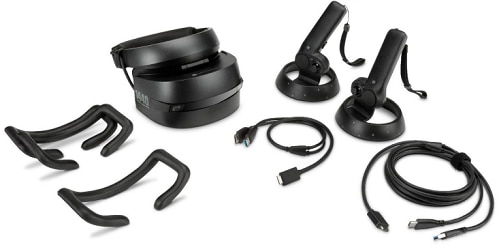
Рекомендуемые минимальные характеристики рабочей станции
|
Характеристики |
Описание |
|
Графическая карта |
Поддерживаются графические карты DX12 NVIDIA GTX 1060 NVIDIA Quadro P4000 AMD Radeon Pro WX 7100, аналогичная или более производительная |
|
Процессор |
Intel Core i7 Intel Xeon E3-1240 v5, аналогичный или более производительный |
|
Память |
ОЗУ: 16 ГБ (или больше) |
|
Видеовыход |
HDMI 2.0 DisplayPort 1.3 (требуется адаптер DP/HDMI 2.0) |
|
Порты USB |
(1) USB 3.0 |
|
Операционная система |
Рекомендуется Windows 10 Pro Fall Creators Update |
Технические характеристики продукта
Гарнитура HP Windows Mixed Reality
Рис. : Гарнитура HP Windows Mixed Reality
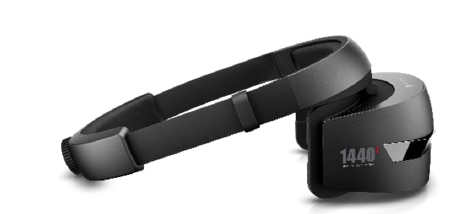
|
Характеристики |
Описание |
|
Экран |
Двойной ЖК-экран диагональю 2,89 дюйма с технологией импульсной подсветки |
|
Разрешение |
1440 x 1440 пикселей на глаз (суммарное: 2880 x 1440 пикселей) |
|
Частота обновления |
90 Гц (HDMI 2.0) 60 Гц (HDMI 1.4) |
|
Поле зрения |
Прибл. 100 градусов, асферическая линза Френеля |
|
Отслеживание |
(2) Фронтальные камеры |
|
Датчики |
Отслеживание перемещения inside-out по 6 степеням свободы на базе платформы Windows Mixed Reality, гироскоп, акселерометр и магнитометр |
|
Регулировка для глаз |
63 мм +/- 8 мм с отслеживанием движений глаз и программным управлением |
|
Подключение |
(1) Кабель «2-в-1» (HDMI 2.0 + USB 3.0), 3,6 м (1) Кабель «2-в-1» (HDMI 2.0 + USB 3.0), 0,6 м |
|
Аксессуары |
Три полиуретановые накладки для лица (очищаемые, съемные) |
|
Механический идентификатор |
Кольцевое головное крепление с ручкой с трещоточным фиксатором для быстрой регулировки Головное крепление оснащено передней и задней накладками для удобной посадки Откидная конструкция Сменные накладки для лица |
|
Размеры |
339 x 176 x 128 мм (13,34 x 6,93 x 5,03 дюйма) |
|
Вес (без кабеля) |
524 г (1,16 фунта) |
Контроллер Windows Mixed Reality
Рис. : Контроллер Windows Mixed Reality

|
Характеристики |
Описание |
|
Датчики |
Отслеживание на базе Windows Mixed Reality Инерционное измерительное устройство Активные светодиоды |
|
Подключение |
Bluetooth |
|
Ввод |
Многофункциональная сенсорная панель Кнопка «Меню» Кнопка «Пуск» Windows Кнопка захвата Аналоговый стик (телепортация и поворот) Триггер (выбор) |
|
Электропитание |
(2) Батареи типа AA для каждого контроллера (в комплекте с решением) |
|
Размеры (Ш x Г x В) |
152 x 120 x 120 мм (6 x 4,7 x 4,7 дюйма) |
|
Вес (без кабеля) |
173 г (0,38 фунта) |
Требования к отслеживаемой области
|
Характеристики |
Описание |
|
Стоя/сидя |
Минимальные требования к пространству отсутствуют. |
|
Размеры помещения |
Мин. 2 x 1,5 м Макс. 5 x 5 м |
Комплектация
|
Характеристики |
Описание |
|
Содержимое |
(1) Гарнитура Windows Mixed Reality (1) Кабель для подключения гарнитуры к настольным и мобильным ПК, 3,6 м (1) Кабель для подключения к портативному ПК с поддержкой виртуальной реальности HP Z VR Backpack, 0,6 м (ПК HP Z VR Backpack приобретается отдельно) (2) Контроллера перемещения (3) Полиуретановых (PU) накладки для лица Руководство по настройке |
|
Гарантия |
Ограниченная гарантия на 1 год |
Microsoft’s Windows Mixed Reality system is a unified virtual reality platform for VR headsets made by a variety of different manufacturers, and we just finished testing our second headset that uses it. The HP Windows Mixed Reality Headset is a $449.99 device that includes both the headset and two motion controllers, designed to work with Microsoft’s VR platform. Apart from some visual differences, the headset performs identically to the first Windows Mixed Reality headset we tested, the Acer AH101-D8EY. It’s easy to set up, but we still find the HTC Vive, Oculus Rift, and Sony PlayStation VR to offer better experiences and a wider selection of software.
Design
The HP Windows Mixed Reality Headset is physically very similar to the Acer headset, but with a much more neutral matte black finish. The headset itself consists of a large visor mounted on a padded headband with a hinge that lets it flip up and down over the eyes. The front of the visor features a long stripe of glossy black plastic over the matte black body, covering the two cameras used for position tracking and giving the visor an almost Robocop look. A 3.5mm headphone jack sits on the right edge of the underside of the visor.
The headband is a horizontal loop of black plastic with thick padding on the front and back. A wheel on the back tightens and secures the headset, like the Acer model and the PlayStation VR. A short cable extends from the right side of the visor to the right side of the headband, held loosely under a plastic loop and terminating a few inches down in a wide connector. The connector attaches to the 10-foot cable that connects to your computer, ending in a USB 3.0 plug and an HDMI plug.
Similar Products
The included motion controllers are identical to the ones included with the Acer headset, and seem to be universal among Windows Mixed Reality products according to Microsoft’s documentation. They’re plain black wands that curve forward to a control surface featuring a clickable analog stick and touchpad, along with Menu and Windows buttons. Two triggers sit on the underside of the control surface. A wide ring covered in white LEDs extends forward past the grip of each controller, letting the headset’s cameras identify its position and orientation. The controllers take AA batteries and pair through Bluetooth. They’re functional, but we prefer the Oculus Touch controllers for their much more ergonomic design.
Windows Mixed Reality
Setting up the HP headset is the exact same process as setting up any Windows Mixed Reality headset. You need Windows 10 with the 2017 Fall Creators’ Update installed. All you have to do is plug the headset into your computer’s open HDMI and USB ports and follow the prompts on your monitor. It will set up the headset, walk you through pairing the two controllers, and then invite you to define a play area by drawing a box in the air around an open space where you can comfortably move (and where the headset cable can still reach your computer without any danger of getting yanked or tripped on).
After everything is set up, you can use Windows Mixed Reality by opening the Windows Mixed Reality app and putting the headset on your head. The software will also automatically start when you plug in the headset, if you keep it unplugged when not in use.
The Windows Mixed Reality interface is identical across all compatible headsets, and we go into greater detail in our review of the Acer headset. Microsoft’s VR interface is called the Cliff House, and it’s a modeled 3D space where you can place different windows and 3D constructs as you see fit. Non-VR Windows apps can be attached to blank walls or left floating in the air to let you look between them as if you were looking between computer monitors. You can even open your PC’s desktop as a window in Mixed Reality, letting you interact with any of your Windows software as if you are literally staring at your monitor. VR apps are generally large tiles that take you directly into the experience when you click on them, dissolving the Cliff House and opening the software before your eyes.
The Cliff House is a functional interface that lets you arrange your most commonly used apps comfortably across different rooms. It’s very limited, though; while you can decorate it with 3D «Holograms» you can scale and place anywhere around you, you can’t change the layout of the Cliff House itself. An option to turn the Cliff House into a large, open warehouse space, or otherwise shape your own rooms and hallways, would add a lot of personalization to the experience.
Microsoft’s app store doesn’t offer many Windows Mixed Reality apps yet. There are a few dozen choices, with standouts like Superhot VR and Minecraft among droves of very simple, tech demo-like games and experiences.
SteamVR Support
You can use SteamVR software with a Windows Mixed Reality headset, but it’s unwieldy and unreliable. You need to install SteamVR for Windows Mixed Reality over Steam, then open the Windows Mixed Reality portal. After that, you need to manually open the SteamVR software you want to use in Steam, after which the Cliff House will disappear and the SteamVR software will load.
This works in theory, but I’ve experienced multiple crashes and hangs when running SteamVR games. Rick & Morty: Virtual Rick-ality is the biggest culprit, loading only the opening menu interface but crashing whenever I try to insert a virtual game disk to play one of the games.
VR software on the Oculus Rift store officially cannot be played in a Windows Mixed Reality headset at this time, but some users have found workarounds to get the store working with them.
Desktop and Backpack
We tested the HP Windows Mixed Reality Headset on a Razer Blade Pro and HP’s own Omen X Compact Desktop PC, a system designed to work with a backpack harness and batteries to let you use virtual reality freely, without any wires running from you to a separate device on a table or desk. Both PCs support Windows Mixed Reality Ultra, which we directly compare with the Rift and Vive experiences.
The experience on both PCs was nearly identical, though the Omen X enables, with an optional $500 VR Backpack, using the headset completely untethered from a desk or power outlet. For more details on what the backpack-worn computer is like, read our full review of the system.
Graphics and Performance
Each eye receives a 1,440-by-1,440 picture across a 2.89-inch LCD, the same resolution used by the Acer headset. It’s a higher-resolution picture than the HTC Vive, Oculus Rift, and PlayStation VR, but the refresh rate offered by Windows Mixed Reality headsets varies between 60 and 90Hz, while the Vive and Rift maintain a flat 90Hz and the PS VR can hit 90 to 120Hz.
This will of course depend on your hardware. Microsoft breaks up Windows Mixed Reality into two categories: Windows Mixed Reality and Windows Mixed Reality Ultra. On paper, even a computer with integrated graphics can run standard Windows Mixed Reality, which only hits 60Hz and isn’t capable of showing as much detail as Ultra, which requires discrete graphics. Effectively, Windows Mixed Reality Ultra is a similar experience to HTC Vive and Oculus Rift, and non-Ultra Windows Mixed Reality is scaled back to run on hardware that the other two PC-tethered headsets don’t attempt.
The headset’s display looks bright and fairly sharp, though I kept noticing the texture of the LCDs themselves when looking at bright, evenly colored surfaces. I could also make out pixel placement, which gave those flat colors a bit of fuzziness. We saw a similar issue with the Acer headset, which appears to use a very similar LCD for each eye. While the HTC Vive, Oculus Rift, and PS VR have lower resolutions for each eye, we didn’t notice this slight fuzziness with their OLED screens, which appear much more vibrant and offer better contrast.
The gaming experience on the HP headset is likewise nearly identical to the Acer headset. Games and tech demos in Windows Mixed Reality, like Minecraft VR and the LEGO Batman Batmersive VR Experience (a 360-degree video experience) function well, and moving through the Cliff House with the motion controllers is reliable and consistent. However, another game in the Microsoft app store, Paint Arena, is awkward and unresponsive, failing to work correctly with the motion controls and rendering the game unplayable.
Still Needs Work
The HP Windows Mixed Reality Headset is just as capable a VR headset as the Acer model. Whether that makes it worthwhile to you depends on whether the Windows Mixed Reality ecosystem is your preferred VR platform (or if you really are dedicated to PC-tethered VR in the first place). We’re starting to see a consistent level of quality and specs coming out of the Windows Mixed Reality field, with similar headsets and identical controllers. They’re functional, but Windows Mixed Reality itself lags behind SteamVR and Oculus in terms of compelling software, and SteamVR for the platform remains inconsistent.
Add LCD screens that simply don’t look quite as good as the OLED screens used by HTC, Oculus, and Sony, and there really isn’t a very solid argument for spending $450 on the HP headset, or any Windows Mixed Reality headset. If the platform and hardware improve in the future this might change, but with two Windows Mixed Reality headsets under our belt, we’re starting to see a pattern of performance that feels markedly behind the competition.
Like What You’re Reading?
Sign up for Lab Report to get the latest reviews and top product advice delivered right to your inbox.
This newsletter may contain advertising, deals, or affiliate links. Subscribing to a newsletter indicates your consent to our Terms of Use and Privacy Policy. You may unsubscribe from the newsletters at any time.
